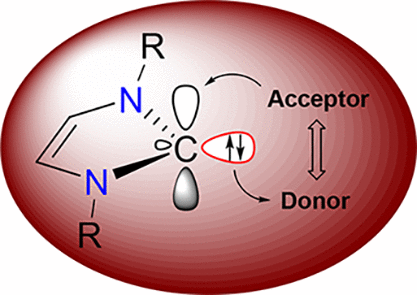当前位置:
X-MOL 学术
›
Chem. Rev.
›
论文详情
Our official English website, www.x-mol.net, welcomes your feedback! (Note: you will need to create a separate account there.)
Electronic Properties of N-Heterocyclic Carbenes and Their Experimental Determination
Chemical Reviews ( IF 62.1 ) Pub Date : 2018-03-30 00:00:00 , DOI: 10.1021/acs.chemrev.8b00067 Han Vinh Huynh 1
Chemical Reviews ( IF 62.1 ) Pub Date : 2018-03-30 00:00:00 , DOI: 10.1021/acs.chemrev.8b00067 Han Vinh Huynh 1
Affiliation

|
N-Heterocyclic carbenes (NHCs) have become without doubt one of the most exciting and popular species in chemical science due to the ease of their preparation and modularity in stereoelectronic properties. Numerous types of NHCs have been prepared, and various experimental methodologies have been proposed for the study of their electronic properties in order to rationalize reactivities observed. The objective of this article is to provide a comprehensive overview of the most common and popular ones among them. In particular, these include the nickel(0)-based TEP, its rhodium(I) and iridium(I) variants, LEP and related electrochemical methods, the palladium(II)-based HEP, phosphinidene- and selenourea-based methods, as well as the use of direct 1J(C–H) coupling constants of the precarbene carbon in azolium salts. Each individual method and the underlying principle of detection it utilizes will be critically discussed in terms of strength and weakness. In addition, comprehensive amounts of data from various NHCs are compiled for the purpose of comparison. These are also meant to help the scientist in better understanding their own research data and possibly providing directions for their future research, which rely on the unique electronic properties of NHCs.
中文翻译:

N-杂环卡宾的电子性质及其实验测定
N-杂环卡宾(NHC)毫无疑问已成为化学科学中最令人兴奋和最受欢迎的物种之一,因为它们易于制备且具有立体电子性质的模块性。已经制备了许多类型的NHC,并且已经提出了各种实验方法来研究它们的电子性质,以便合理化所观察到的反应性。本文的目的是对其中最常见和最受欢迎的内容进行全面概述。特别是,这些包括基于镍(0)的TEP,其铑(I)和铱(I)变体,LEP和相关的电化学方法,基于钯(II)的HEP,基于次膦基和硒基的方法,例如以及直接使用1 J偶氮盐中前卡宾碳的(C–H)耦合常数。将就强度和弱点严格讨论每种方法及其所采用的检测原理。此外,为了比较起见,还汇总了来自各种NHC的大量数据。这些还旨在帮助科学家更好地了解他们自己的研究数据,并可能为依赖NHC独特电子特性的未来研究提供指导。
更新日期:2018-03-30
中文翻译:

N-杂环卡宾的电子性质及其实验测定
N-杂环卡宾(NHC)毫无疑问已成为化学科学中最令人兴奋和最受欢迎的物种之一,因为它们易于制备且具有立体电子性质的模块性。已经制备了许多类型的NHC,并且已经提出了各种实验方法来研究它们的电子性质,以便合理化所观察到的反应性。本文的目的是对其中最常见和最受欢迎的内容进行全面概述。特别是,这些包括基于镍(0)的TEP,其铑(I)和铱(I)变体,LEP和相关的电化学方法,基于钯(II)的HEP,基于次膦基和硒基的方法,例如以及直接使用1 J偶氮盐中前卡宾碳的(C–H)耦合常数。将就强度和弱点严格讨论每种方法及其所采用的检测原理。此外,为了比较起见,还汇总了来自各种NHC的大量数据。这些还旨在帮助科学家更好地了解他们自己的研究数据,并可能为依赖NHC独特电子特性的未来研究提供指导。



























 京公网安备 11010802027423号
京公网安备 11010802027423号